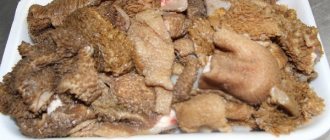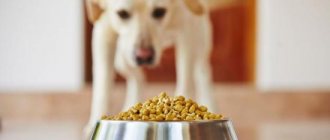Chicken as dog food
It is acceptable to feed a dog chicken if the breed is not prone to allergies and if the pet does not have an individual reaction to chicken.
Experts usually recommend giving boiled chicken. Raw poultry may contain salmonella.
You need to understand that the nutritional value of cooked meat compared to raw meat for a dog is low. You have to give more of any boiled meat than raw meat, but the benefits are less. Therefore, chicken can under no circumstances replace beef or lamb in a complete diet. But it can be added to the dog menu.
Chicken by-products are less likely to cause an allergic reaction than chicken meat. However, they should be introduced into the diet with caution, carefully monitoring the reaction.
Video “What food is best to give to dogs”
A caring owner strives to make his dog’s diet balanced and varied. If you include chicken necks in it, your pet will receive vitamins and minerals.
This product is beneficial, but is unfairly rejected by dog breeders. Experts are confident that it can and should be included in the menu.
The benefits of chicken necks for dogs are as follows:
- it is a source of animal protein and calcium;
- while consuming this product, the gums are massaged;
- the replacement of milk teeth with permanent ones is accelerated;
- bones are strengthened;
- The beneficial substances in the product increase the dog’s endurance, make it playful and joyful.
This product is most useful for puppies who need to strengthen their teeth and bones. Their body is actively growing and developing, and the digestive system is just getting used to different foods.
Chicken necks are easily digestible and have a beneficial effect on the pet’s musculoskeletal system. If his teeth are changing, this food will speed up the process. It will go away faster and will avoid severe pain and discomfort in the gums.
Is it possible to feed chicken by-products?
Feeding a dog chicken by-products is a double-edged sword, and even veterinarians do not have a consensus on this matter. On the one hand, in their raw form they can contain harmful bacteria, antibiotics, and other harmful additives. On the other hand, when boiled, the nutritional value is lost.
The issue is especially controversial with chicken heads, paws and other parts containing bones. Boiled bones are not recommended.
Chicken heads
Disputes about whether it is possible to give chicken heads to dogs do not subside on dog breeders forums. Many pet owners say that they give their dogs chicken heads as the main source of protein daily, and the four-legged animals feel great. Proponents of such nutrition remind us that in nature a predator eats its prey with its head, and this does not cause any harm to it.
And although there are no tubular bones in the head, veterinarians do not advise doing this. If you decide to give your animal chicken heads, do not do it every day. The head has little protein and a lot of bones; it cannot replace meat. The beak must be removed. It contains nothing useful and is dangerous for the esophagus.
Dog owners living in rural areas should also remember that a dog accustomed to chicken heads may one day break loose and run out into the street. Such an animal is almost guaranteed to kill all the chickens and other poultry it encounters.
Should I give it to my pet or not?
The dog's diet should be based on animal proteins, which are found in natural food. For pets, lean meat is suitable, which may contain cartilage and tendons, as well as a small amount of fat. Some meat can be replaced with offal, which includes animal entrails, ears, lips, blood, udder, and bone offal. The legs, joints, heads and bones after cutting the carcass contain protein, which has low biological value, but also a lot of fat. When feeding puppies with bone by-products, you need to add food with a high protein content.
Chicken by-products, such as entrails, paws, skin, bones, heads, necks, skeletons with fat trimmings, have a high energy value and are liked by four-legged pets. Chicken meat rarely causes an allergic reaction in dogs, so it can be used when creating a dietary menu.
Chicken bones
As soon as a puppy appears in the house, the first question that arises is about feeding it. A young body requires a variety of nutrients that are essential for the developing body. Bones are the most important product for puppies; they contain building materials such as protein, calcium, lime, glue, etc. It is useful for young dogs to chew on bones, especially when teeth change between the ages of 4 and 6 months, this speeds up the change process.
Animal bones are useful as a source of calcium. Its meat contains little, more phosphorus, and calcium is more beneficial for dogs than phosphorus. Calcium contained in bones is easily absorbed. If bones are regularly present in the dog’s diet, there is no need for additional calcium supplementation. Bones should be given raw. Gastric juice dissolves them, and they become a source of natural calcium and phosphorus, as well as substances that are material for the formation of joint cartilage. But chicken tubular bones are strictly contraindicated!
It is especially dangerous if the dog has eaten enough boiled bones; when cooked, all the nutrients are removed from them, they change their structure and when they enter the stomach they simply turn into dust.
Long bones are very dangerous, especially for small breeds of dogs. They are fragile and, when chewed, break into sharp pieces that can damage the animal's esophagus, which is why they should not be given.
Bones should not be given as the main food: they are poorly digested and can cause constipation, intestinal obstruction, and volvulus. In adult dogs, bones are quickly worn down by teeth. If a dog has eaten tubular bones, you need to monitor it; if any problems arise, you should immediately consult a doctor.
Soft bones can be given as a treat after your dog has eaten a hearty dinner. A well-fed dog will not greedily gnaw on them, but can prolong its pleasure by savoring the bone for a long time.
Chicken heads
If the dog is not allergic to chicken by-products, then you can feed it chicken heads. Raw heads need to be cut into several particles, add porridge or vegetables with vegetable oil to them. At the same time, there are no tubular bones in the heads, which are harmful to four-legged pets. The only thing is that the beaks should be removed, they have no value, they are not digested. If a dog has eaten heads with beaks, they can cause the animal to burp.
Sorry, there are no surveys available at this time.
Chicken necks
Puppies from the age of two months can be given necks either whole or in the form of minced meat. It is advisable to scald raw necks with boiling water. However, you should not feed them more than three times a week. While there is a danger from small bones in the paws and wings, there are no bones in the necks, so you can safely feed even small dogs. Pets enjoy chewing on them. Adult animals can also be fed chicken necks 1-2 times a week.
Necks can be given to clean teeth and massage gums.
Chicken feet
There are many opinions both for and against. Many people give the paws raw; they are then easily digested by the dog, although the claws must be removed. There is an opinion that it is better to give chicken feet in the form of jellied meat, which will even be useful for growing puppies. If you regularly feed puppies jellied meat, it can replace industrial chondroprotectors.
Preparing jellied meat is not difficult. Place the paws in a thick-walled pan and fill them with water. Bring to a boil, and then, reducing the heat to low, cover the pan with a lid and cook for 5 hours. After cooking, you need to remove the bones, leaving the soft tissue. When the jellied meat has cooled down, you can give it to your pet. Boiled bones should not be given to avoid blockage of the gastrointestinal tract and punctures of the esophagus.
Paws consist of tubular bones, this is one of the reasons why many dog breeders do not give them as food to their pets. If the dog has eaten tubular bones, then you need to monitor its feces. If bloody traces are found, you need to contact a veterinary clinic.
Some dog owners feed their pets paws and porridge all the time, but this should not be done. You cannot feed only paws; they can be given as additional food, but not often, since a lot of toxins and waste accumulate in the bones. The diet should be varied so that the animal receives all the nutrients. When giving raw chicken feet, it is advisable to pour boiling water over them, as they can be dangerous.
Veterinarians' opinions also vary. Australian veterinarian Ian Billinghurst conducted research according to which he found that dogs eating natural food live longer than their counterparts eating food. In his book, he bases his conclusions on the fact that the dog is a carnivore with strong teeth for chewing and tearing meat. In addition, it has a short digestive tract, which contains enzymes that help digest raw animal protein. Therefore, Billinghurst recommends feeding meat bones, such as turkey and chicken wings, as well as necks.
By-products are fed to dogs in kennels. Chicken by-products contain a large amount of collagen, for example, in necks and wings - 20-30%, in paws - 60-70% of the total protein. In heads and paws, digestible protein is 12.3%, and fat is 6.8%. Since chicken fats quickly oxidize even at low temperatures, offal can be stored for no more than 3-4 months. To reduce the risk of contracting infectious diseases, it is better to boil offal or scald it with boiling water.
Veterinarians believe that dogs are different and the reaction of each organism to raw meat products is individual due to the characteristics of the gastrointestinal tract. Therefore, in each case you need to decide personally what food to give your pet.
If the dog was fed dry food from birth, then when switching to chicken by-products, vomiting and diarrhea may occur, since natural food requires more gastric juice than dry food. Therefore, the transition to natural food should be gradual. If the dog ate the food and burped, there is no need to do anything in this case; you can even let the dog eat what it burped.
Reviews
Vladimir, Astrakhan region
“The dog is a predator! Do you think someone cuts the beaks and claws for the wolf? They all eat great and feel great! Our Prince (shepherd) eats chicken heads all his life, he is in excellent health, he is very large and strong. I put one and a half kilograms of chicken heads on a pan of porridge (rice or buckwheat). In the morning there are a dozen paws. I don’t cook them, I put them in the microwave for five minutes.”
Irina, Vladivostok
“Mila once ate bones... I thought we wouldn’t save her. They performed abdominal surgery. Luckily, she pulled through. I will never give her any bones or offal. Dry food is better. I don’t want to save on her health.”
How to give?
You are allowed to feed your pet this dish twice a week. A serving should be 50-60 g, but no more. It is better to feed necks in small portions to avoid overeating. They are given whole, having first been doused with boiling water or boiled.
This product can be independent, but to make it tastier, vegetables and cereals are added to it. The result will be a more satisfying and tasty dish.
Raw
In its raw form, this product can be given in moderation. The main thing is to pour boiling water over it before consumption to destroy germs and prevent poisoning. Without this procedure, your dog may develop an infection due to bacteria in the raw product.
If a dog has eaten a lot of raw necks, it will feel heaviness in the stomach, weakness, and dizziness. But this will happen not because the product is raw, but because it was eaten in large quantities.
The benefits and harms of using chicken necks, paws, heads in a dog’s diet
Chicken necks for dogs can
Animals at any age need a sufficient supply of calcium, which is responsible for the condition of the teeth and bone skeleton. It helps babies develop properly, and the protein present helps strengthen the muscle corset and normalize the functioning of the digestive tract.
Necks
Inexperienced four-legged owners are wondering whether dogs can have chicken necks. The product is permitted; it contains a small amount of fat, meat, skin and bones. It is given raw or cooked, minced meat, soups or broths are made from it. The main advantages of chicken necks:
- it is a supplier of calcium and protein;
- they massage the gums well;
- bones help to painlessly change teeth (reduce itching and discomfort);
- due to them, bone tissue is strengthened;
- they do not contain sharp fragments or tubular bones;
- This is a great treat for pets.
The products are completely absorbed by the body and help add variety to the daily menu. Neck dishes are satisfying and provide a sufficient amount of energy and strength. The harms from eating necks include:
- indigestion - due to overeating;
- poisoning - when using products of dubious quality and eating stale necks.
Important! Large volumes of the same food are harmful to your pet's health due to excess protein intake. Its increased amount provokes metabolic disorders, leading to constipation and increased gas formation. You shouldn’t constantly feed the animal’s necks just because the owner doesn’t know where to put the remaining chicken or turkey parts.
Bird necks
Heads
The most useful thing about them is the brain, which contains sufficient proportions of vitamin B12. It helps the nervous and muscular systems develop normally, and regulates the production of antibodies in the circulatory system. Dog handlers pay attention to the following features of the product:
- It does not undergo full control - due to the fact that a person does not eat chicken heads, one can accidentally purchase an infected or expired offal.
- If your pet has a small mouth or a habit of greedily swallowing food, he may choke - before serving the food, it must be crushed into small pieces.
- Long bone content – these are present if the heads are not separated from the neck, leading to an increased risk of esophageal injury.
- Accidental use of the beak - in mild cases the animal suffers from severe flatulence and belching, in severe cases it can choke or injure the gastrointestinal mucosa.
The product is not considered ideal - a pet can eat a lot, but continue to ask for food. This problem arises when pre-cooking heads, from which all the fat is lost in the process. The by-product loses its energy value without reducing the animal’s sense of hunger.
On a note! The body of a growing puppy requires more calories and an adequate supply of proteins, fats and carbohydrates. The by-product can be a supplement, but not the main source of their production.
Heads and paws
Paws
Chicken feet for dogs cause a lot of controversy, many breeders have an extremely negative attitude towards them. When feeding dogs this product, you need to remember the following rules:
- remove claws and bones from the dish;
- Be sure to scald with boiling water.
Peculiarities of processing are associated with the risk of wounds to the stomach, esophagus and intestines from claws and tubular bones. Sharp fragments will certainly damage the mucous membranes, so all “extra” ingredients must be removed. With prolonged cooking, they will soften, but the result of such cooking will be their accumulation in the intestinal tract and its blockage.
Dog trainer advice
Some owners, after first removing the bones and claws, prefer to create jellied meat from the limbs. It can be used rarely, while the pet is growing. The finished product contains natural gelatin, which is necessary to strengthen joints.
Chicken legs cannot be used as a main dish; they can only be an additional component of the main menu. If after taking them the dog’s behavior or general condition has changed, then it is better to visit a veterinary clinic and undergo a course of therapy.
Important! The benefits and harms of chicken heads for dogs are the same as those of other offal. Their use should be limited and subject to safety precautions. A delicious treat for a pet can result in long-term treatment or surgery.
Is it possible to give your dog chicken feet?
A dog may choke on a chicken bone.
The main problem is that chicken feet (if given whole) contain dangerous tubular bones, and in addition to them, they also have rather sharp claws. To make the product safe for the dog, jellied meat is boiled from the paws, removing both bones and claws from it (when it is ready). You will have to tinker, but your pet will receive tasty and, most importantly, healthy food. For puppies, this is an excellent supplement that strengthens the growing body, especially the joints.
True, it is not recommended to partake of such treats. Everything is good in moderation.
If you give your pet raw chicken feet, you must follow the following rules:
- remove bones from them,
- cut off claws
- scald with boiling water
- Do not give it “pure”, be sure to mix it with porridge.
What by-products can be included in the diet?
Your dog may benefit from the following chicken products:
- heads,
- paws,
- liver,
- stomachs.
Chicken heads
Is it possible to give chicken heads to a dog? Yes, this offal is allowed, but only for pets of medium and large breeds. If you are confused by the beak, then you should note that most dogs simply do not eat it. The head with its soft bones is eaten, and the beaks are literally spat out. But it is important to ensure that this is the case. Some individuals, especially young and large ones, can swallow their beaks. They are difficult to digest and may cause complications. The heads are suitable for preparing porridge as an addition to other ingredients.
Important ! Chickens have a lot of bones in their heads! Although they are soft, chewed and digested well, they should not be taken as the basis of the diet.
Plus they are not very nutritious. Keep this in mind when purchasing chicken heads for dogs.
Chicken necks
Is it possible to give chicken necks to a dog? Necks will become, perhaps, the animal’s most favorite dish. They can be fed boiled with porridge or fed to the dog raw, but previously frozen. For example, the American BARF nutrition system recommends feeding your pet raw necks as the basis of the diet. Can a dog take chicken necks as the basis of its daily diet? There are a lot of muscle fibers on the necks, and the bones are easy to chew, but it is recommended to supplement the meat component of the diet with offal or meat from other farm animals.
Chicken feet
Is it possible to give your dog chicken feet? Paws are not good for your pet. Their nutritional value is low, and the bones can even harm an adult dog, not to mention puppies. They can be used after boiling and picking out the pulp, along with porridge. Large dogs are given whole ones, but not often and in extreme cases. If there is a different food supply, the paws should be discarded.
Offal: liver and gizzards
Chicken gizzards are very nutritious and, given the right quality, will be an excellent food for your dog. They should be cooked together with porridge. How long to cook chicken gizzards for dogs? The stomach of adult chickens is boiled for a long time - 1.5 hours under the lid, or 30 minutes. in a pressure cooker. Stomachs of young chickens - 0.5 hours on fire or 15 minutes. in a pressure cooker. Then the porridge is boiled in broth and mixed with chopped gizzards.
Can a dog have chicken liver? The liver of chicken from poultry farms is often not of very good quality; it is better not to use it for food. But if there is a high-quality offal, it will perfectly complement the dog’s diet. The liver of domestic chickens raised without feed and growth hormones is especially good, as is their stomach, but these days they are a delicacy. Liver as the basis of the diet is not recommended.
Is it possible to give chicken necks to a dog?
Chicken necks do not have tubular bones, which makes it possible to include the product in the dog menu. They are given raw, as boiled ones can cause intestinal obstruction. In addition, raw necks contain more useful substances than a heat-treated product.
The necks are given whole, having previously been doused with boiling water, or in the form of minced meat. Adult pets are given this food once or twice a week, puppies – up to three times. You can introduce chicken necks to your dog’s menu starting from the age of two months.
Reference:
Unlike wings and paws, chicken necks do not have small, dangerous bones, so they can be used as food even for small dogs.











